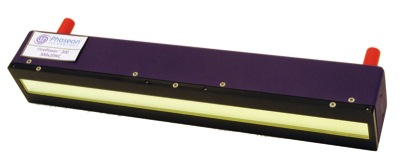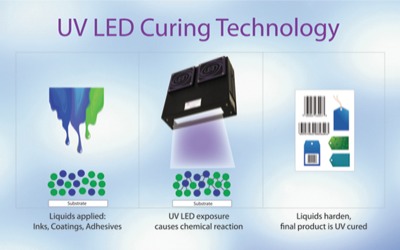There are many advantages of UV LED curing technology in terms of capabilities, economics and environmental benefits. Sara Jennings, customer programme manager, Phoseon Technology, explains.
UV LED curing refers to a technique that utilises energy output from light emitting diodes (LEDs) in the ultraviolet (UV) spectrum to treat inks, coatings, adhesives and other UV curable materials.
The energy generated by the ultraviolet light triggers a chain reaction resulting in polymerisation of the material thus hardening (or curing) the material.
Traditionally, mercury-based UV lamps have been utilised for curing, but now more energy efficient and environmentally friendly LED-based UV technology has proven a superior solution to the printing industry. LED curing technology uses semiconductorbased LEDs to project UV light when an electric current is passed through them.
When an LED is forward-biased, electrons are able to recombine with electron holes within the device thus releasing energy in the form of photons. The colour of the light emitted or corresponding energy of the photon is determined by the energy gap of the semiconductor material.
Benefits
More and more end users are adopting UV curing using LED instead of mercury arc lamps because of the substantial benefits. Customers who have purchased UV LED curing printers have discovered they can print on a far wider range of materials than they could with mercury UV technology.
Printer manufacturers are finding they can design smaller devices with the smaller UV LED systems, and as these pose fewer heat dissipation challenges, can be used for short runs, print on demand and even personalisation of objects.
UV LED curing offers advanced capabilities, economic and environmental advantages beyond anything available on the market today. UV LED lights have a narrow spectral output centred on a specific wavelength, +/- 5 nano metres (nm).
LEDs are a solid state device; they can be built with various wavelength diodes including but not limited to, 395nm, 365nm, 385nm, 405nm and 410nm, unlike broad spectrum of wavelength range output by Hg-based lamps. This monochromatic distribution (see chart below) requires new chemical formulations to ensure proper curing of UV materials (ink). Currently, the most popular wavelength is 395nm, with 365nm being used in specific applications.

Inks
Ink formulation for LED technology has evolved significantly, and today, there are a growing number of suppliers developing narrow web inks that work well with LED technology.
As the technology has become more powerful and more compatible inks are available, this has resulted in substantial advanced capabilities for UV printing. Material suppliers have responded to the demand and challenge from the printing world to formulate raw materials that absorb energy corresponding to the wavelength of UV LED light sources.
One of the key ingredients in the chemical formulation is a photoinitiator that serves as a catalyst to initiate the polymerisation process when exposed to narrow spectrum UV LED energy.
With the continued widespread acceptance of UV LED systems, availability of suitable base materials continues to grow. The driving factors in advancement of chemistry of raw materials are increased capability and cost effectiveness of commercially available UV LED light sources.






